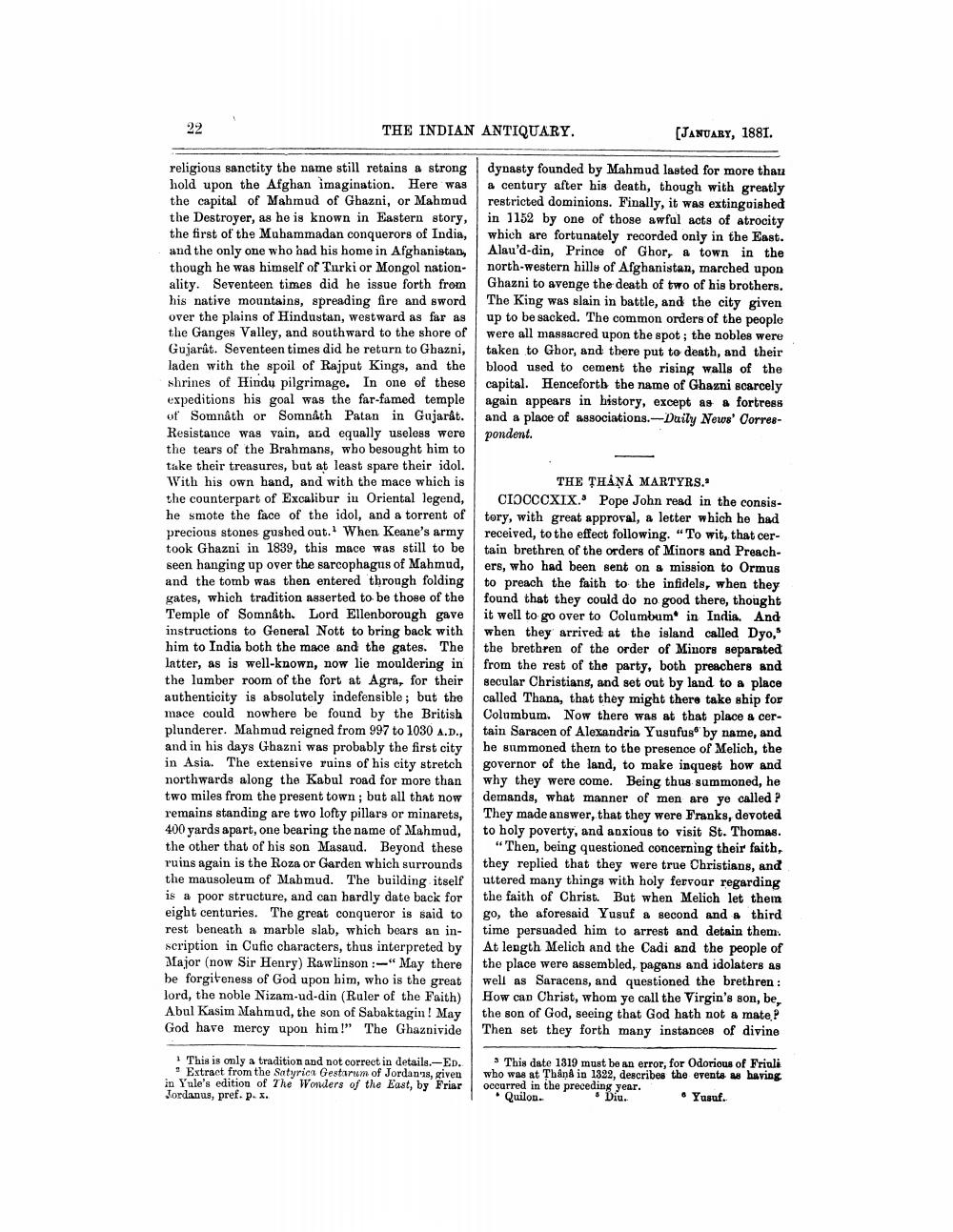________________
22
THE INDIAN ANTIQUARY.
(JANUARY, 1881.
dynasty founded by Mahmud lasted for more than a century after his death, though with greatly restricted dominions. Finally, it was extinguished in 1152 by one of those awful acts of atrocity which are fortunately recorded only in the East. Alau'd-din, Prince of Ghor, a town in the north-western hills of Afghanistan, marched upon Ghazni to avenge the death of two of his brothers. The King was slain in battle, and the city given up to be sacked. The common orders of the people were all massacred upon the spot; the nobles were taken to Gbor, and there put to death, and their blood used to cement the rising walls of the capital. Henceforth the name of Ghazni scarcely again appears in history, except as a fortress and a place of associations.-Daily News' Correspondent.
religious sanctity the name still retains a strong hold upon the Afghan imagination. Here was the capital of Mahmud of Ghazni, or Mahmud the Destroyer, as he is known in Eastern story, the first of the Muhammadan conquerors of India, and the only one who had his home in Afghanistan, though he was himself of Turki or Mongol nation- ality. Seventeen times did he issue forth from his native mountains, spreading fire and sword over the plains of Hindustan, westward as far as the Ganges Valley, and southward to the shore of Gujarat. Seventeen times did he return to Ghazni, laden with the spoil of Rajput Kings, and the shrines of Hindu pilgrimage. In one of these expeditions his goal was the far-famed temple of Somnath or Somnath Patan in Gujarat. Resistance was vain, and equally useless were the tears of the Brahmans, who besought him to take their treasures, but at least spare their idol. With his own hand, and with the mace which is the counterpart of Excalibur iu Oriental legend, he smote the face of the idol, and a torrent of precious stones gushed out. When Keane's army took Ghazni in 1839, this mace was still to be seen hanging up over the sarcophagus of Mahmud, and the tomb was then entered through folding gates, which tradition asserted to be those of the Temple of Somnath, Lord Ellenborough gave instructions to General Nott to bring back with him to India both the mace and the gates. The latter, as is well-known, now lie mouldering in the lumber room of the fort at Agra, for their authenticity is absolutely indefensible; but the mace could nowhere be found by the British plunderer. Mahmud reigned from 997 to 1030 A.D., and in his days Ghazni was probably the first city in Asia. The extensive ruins of his city stretch northwards along the Kabul road for more than two miles from the present town; but all that now remains standing are two lofty pillars or minarets, 400 yards apart, one bearing the name of Mahmud, the other that of his son Masaud Beyond these ruins again is the Roza or Garden which surrounds the mausoleum of Mahmud. The building itself is a poor structure, and can hardly date back for eight centuries. The great conqueror is said to rest beneath a marble slab, which bears an inscription in Cufic characters, thus interpreted by Major (now Sir Henry) Rawlinson :-"May there be forgiveness of God upon him, who is the great lord, the noble Nizam-ud-din (Ruler of the Faith) Abul Kasim Mahmud, the son of Sabaktagin! May God have mercy upon him!” The Ghaznivide
THE THÅŅÅ MARTYRS. CIOCCCXIX. Pope John read in the consistory, with great approval, a letter which he had received, to the effect following. "To wit, that certain brethren of the orders of Minors and Preachers, who had been sent on a mission to Ormus to preach the faith to the infidels, when they found that they could do no good there, thought it well to go over to Columbum in India. And when they arrived at the island called Dyo." the brethren of the order of Minors separated from the rest of the party. both preachers and secular Christians, and set out by land to a place called Thana, that they might there take ship for Columbum. Now there was at that place a certain Saracen of Alexandria Yusufus by name, and he summoned thern to the presence of Melich, the governor of the land, to make inquest how and why they were come. Being thus summoned, he demands, what manner of men are ye called ?
They made answer, that they were Franks, devoted to holy poverty, and anxious to visit St. Thomas.
"Then, being questioned concerning their faith, they replied that they were true Christians, and uttered many things with holy fervour regarding the faith of Christ. But when Melich let them go, the aforesaid Yusuf a second and third time persuaded him to arrest and detain them. At length Melich and the Cadi and the people of the place were assembled, pagans and idolaters as well as Saracens, and questioned the brethren: How can Christ, whom ye call the Virgin's son, be, the son of God, seeing that God hath not a mate? Then set they forth many instances of divine
This is only a tradition and not correct in details.-ED. ! Extract from the Satyrica Gestarum of Jordan's, given in Yule's edition of The Wonders of the East, by Friar Jordanus, pref. p...
- This date 1319 must be an error, for Odorious of Friuli who was at Thånd in 1322, describes the events as having occurred in the preceding year. • Quilon.
. Yusuf.
• Diu.




